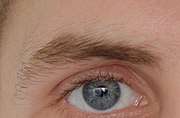Eyebrow
| Eyebrow | |
|---|---|
 A man's eyebrow and eye | |
| Details | |
| Identifiers | |
| Latin | supercilium |
| MeSH | D005138 |
| TA |
A15.2.07.023 A16.0.00.017 |
| FMA | 54237 |
| Anatomical terminology | |
The eyebrow is an area of thick, delicate hairs above the eye that follows the shape of the lower margin of the brow ridges of some mammals. Their main function is to prevent sweat, water, and other debris from falling down into the eye socket, but they are also important to human communication and facial expression. It is common for people to modify their eyebrows by means of hair removal and makeup.
Functions
Physical
It is believed by anthropologists that the main function of the eyebrow is to prevent moisture, mostly salty sweat and rain, from flowing into the eye. Greek physician Herophilos, in his treatise "Anatomy," was among the first to hypothesize such a theory, proposing that the eyebrows are "adorned with hair, so that if copious perspiration came [down], it would be contained by this 'check-point' of hair placed in its way until it is wiped off, so that it could not obstruct the eyes." Due to the typically curved shape of the eyebrow (with a slant on the side) and the direction in which eyebrow hairs are pointed, moisture has a tendency to flow away from the eyes, along the side of the head and along the nose. The slightly protruding brow ridges of modern humans could also be used as a defense structure against the floods of moisture. Together with the brow ridges, the eyebrows also shade the eyes from sunlight. Eyebrows also prevent debris such as dandruff and other small objects from falling into the eyes, as well as providing a sensitive barrier to the eye for detecting small objects, such as insects.
Psychological
Eyebrows have a facilitation function in communication, strengthening expressions, such as surprise or anger. Desmond Morris [1] has suggested that the primary function of the eyebrows is to signal the changing moods of their owners.
As eyespots
Joseph Jordania suggested that clearly visible eyebrows provide safety from predators when early hominid groups started sleeping on the ground, away from the trees, where they were vulnerable to predators. Stealth predators (like big cats) tend to stop hunting if they notice that prey animals are watching them. According to Jordania, at night, when hominid eyes were closed, the eyebrows, arched upwards, and eyelashes, arched downwards, formed clearly definable oval eyespots on a ‘sleeping’ human face, creating an illusion that the eyes were still open and watching (and therefore could deter predators from attacking sleeping hominids).[2]
Trends
In the 1920s eyebrows were worn ultra thin, with a slightly pronounced curve, in order to emulate movie stars such as Clara Bow and Anna May Wong. Stars in the 1930s ditched the sloped look of the previous decade for a rounded upward bend. They also began to fill in their brows with a darker hue, emphasizing the bend. Trends remained similar until the 1960s, when Audrey Hepburn and her thick natural brows, inspired women to fill in their brows to achieve a fuller look.
Cosmetics and modification
Eyebrows are a major facial feature. Cosmetic methods have been developed to alter the look of one's eyebrows, whether the goal is to add or remove hair, change the color, or change the position of the eyebrow.
Eyebrow brushes, shaders, and pencils are often used to define the eyebrow or make it appear fuller. These can create an outline for the brows or mimic hairs where there are sparse areas. Brow gels are also used in creating a thicker brow; they allow for the hairs to be more textured, which gives the appearance of thicker, fuller brows. Lastly, brow powders or even eyeshadows are used for those who want a fuller and more natural look, by placing the brow powder or eyeshadow (closest to the natural hair colour) in areas where there is less hair.
A fairly recent trend in eyebrow modification is in eyebrow tinting: permanent dye, similar to hair colour, is used on the eyebrows, often to darken them.
Several options exist for removing hair to achieve a thinner or smaller eyebrow, or to "correct" a unibrow, including manual and electronic tweezing, waxing, and threading. The most common method is to use tweezers to thin out and shape the eyebrow. Waxing is becoming more popular. Lastly, there is threading eyebrows, where a cotton thread is rolled over hair to pull it out. Small scissors are sometimes used to trim the eyebrows, either with another method of hair removal or alone. All of these methods can be painful for some seconds or minutes due to the sensitivity of the area around the eye but, often, this pain decreases over time as the individual becomes used to it. In time, hair that has been plucked will stop growing back.Some people wax or shave off their eyebrows and leave them bare, stencil or draw them in with eye liner, or tattoo them on. In Western societies, it has become more common for men to pluck part of their eyebrows.
To create a fuller look, eyebrows can be cloned in an eyebrow transplant. Individual strands of the eyebrow are created to mimic a natural-looking eyebrow of the desired shape. The process of eyebrow transplant is quite similar to the process of hair transplant. In this process as well, follicles from an active area are transferred to the area where there are no hairs. Follicles are mostly taken from the back of the head because it is the best harvesting site when it comes to hairs. The follicles are then injected into the skin.
The healing process after an eyebrow transplant is similar to the process of tattoo. In this process, patients may experience light bruising and crusting of the skin. People who have genetically thin eyebrows or who have over-tweezed are considered ideal for the transplant.
An eyebrow lift is a cosmetic surgery to raise the eyebrow, usually to create a more feminine or youthful appearance. It is not a new phenomenon, with the earliest description of brow lifting published in medical literature in 1919 by French surgeon Dr Raymond Passot.[3] Brows can be affected during a face lift or an eye lift. In the seventies, doctors started injecting patients' eyebrows with botox or similar toxins to temporarily paralyse the muscles to raise the eyebrow.[4]
From the 8th century, many Japanese noblewomen practiced hikimayu, shaving or plucking the eyebrow hair and painting smudge-like ones higher on the forehead. Shaving lines in eyebrows is another cosmetic alteration, more common among younger people in the 1990s and 2000s.[5]
A new trend is eyebrow tattoos. This is seen as a way to achieve and maintain an eyebrow shape, achieved by using a coil machine, rotary machine and linear machine. This process, also called cosmetic tattooing, microblading, or blade & shade brows, involves an eyebrow artist making small, precise cuts that mimic the look of hair. Several celebrities have undergone the procedure, including Lorde, Lena Dunham, Adele, and Bella Thorne.[6]
Gallery
 Eyebrows often thicken with puberty.
Eyebrows often thicken with puberty. Eyebrows can be used to convey emotion, such as surprise.
Eyebrows can be used to convey emotion, such as surprise. One of Audrey Hepburn's trademarks was her thick eyebrows.
One of Audrey Hepburn's trademarks was her thick eyebrows. A young adult with hair between the eyebrows - a unibrow
A young adult with hair between the eyebrows - a unibrow
See also
| Wikimedia Commons has media related to Eyebrows. |
- Anti-eyebrow, a body piercing placed below the eyebrow
- Eyebrow piercing, a body piercing done through the eyebrow
- Trichotillomania, a disorder where sufferers have an impulse to pull out body hair, including eyebrows
- Unibrow, the presence of abundant hair between the eyebrows
- Eyebrow restoration, surgical procedure to change the look of one's eyebrows
References
- ↑ Desmond Morris, The Naked Man: A Study of the Male Body. London: Jonathan Cape, 2008
- ↑ Joseph Jordania, Why do People Sing? Music in Human Evolution, chapter "I Can See you! Eyespots in Humans." Logos, 2011, pg. 96
- ↑ "The Evolution of the Brow Lift in Aesthetic Plastic Surgery" (PDF). semanticscholar.org. Retrieved 2018-08-30.
- ↑ "Access". Medscape. Retrieved 2012-06-23.
- ↑ Bruce Ely, The Oregonian (2008-04-28). "Teens shaving lines in eyebrows raise gang concerns in schools". OregonLive.com. Retrieved 2012-06-23.
- ↑ ""Microfeathering" is L.A.'s Latest Brow Trend — & The Results Are SO Natural". Retrieved 2018-09-20.
External links
- IEEE Xplore: About the relationship between eyebrow movements and Fo variations
- Dallas / Fort Worth Local News: Granbury ISD Forbids Eyebrow Shaving